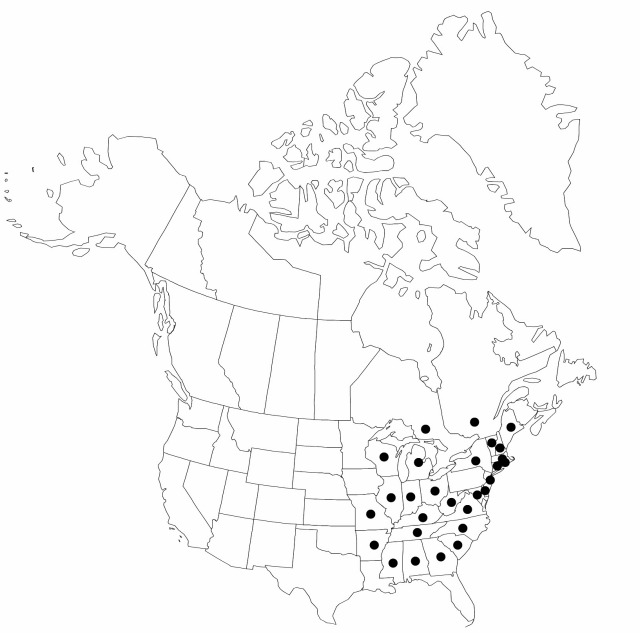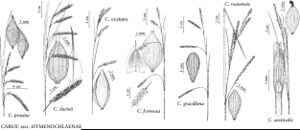Difference between revisions of "Carex prasina"
Kongl. Vetensk. Acad. Nya Handl. 24: 161. 1803.
FNA>Volume Importer |
imported>Volume Importer |
||
| (2 intermediate revisions by 2 users not shown) | |||
| Line 8: | Line 8: | ||
}} | }} | ||
|common_names=Drooping sedge;carex vert poireau | |common_names=Drooping sedge;carex vert poireau | ||
| + | |special_status={{Treatment/ID/Special_status | ||
| + | |code=F | ||
| + | |label=Illustrated | ||
| + | }}{{Treatment/ID/Special_status | ||
| + | |code=E | ||
| + | |label=Endemic | ||
| + | }} | ||
|basionyms= | |basionyms= | ||
|synonyms= | |synonyms= | ||
| Line 44: | Line 51: | ||
|publication title=Kongl. Vetensk. Acad. Nya Handl. | |publication title=Kongl. Vetensk. Acad. Nya Handl. | ||
|publication year=1803 | |publication year=1803 | ||
| − | |special status= | + | |special status=Illustrated;Endemic |
| − | |source xml=https:// | + | |source xml=https://bitbucket.org/aafc-mbb/fna-data-curation/src/2e0870ddd59836b60bcf96646a41e87ea5a5943a/coarse_grained_fna_xml/V23/V23_849.xml |
|genus=Carex | |genus=Carex | ||
|section=Carex sect. Hymenochlaenae | |section=Carex sect. Hymenochlaenae | ||
Latest revision as of 20:43, 5 November 2020
Plants densely cespitose. Culms green or slightly suffused with maroon at base; flowering stems 30–80 cm, usually longer than leaves at maturity, 0.8–1.1 mm thick, glabrous but finely scabrous on angles within inflorescence. Leaves: basal sheaths 2–3, green or tinged with maroon, bladeless, very short or absent, glabrous; others green on back, white-hyaline on front; blades flat, 2–5 mm wide, glabrous. Inflorescences: peduncles of lateral spikes slender, to 4 cm, mostly shorter and usually shorter than spikes, glabrous; peduncle of terminal spike less than 10 mm, minutely scabrous; proximal bracts equaling or exceeding inflorescences; sheaths less than 3 mm; blades 2–3 mm wide. Lateral spikes 2–4, 1 per node, each overlapping 1 above, uncrowded, nodding or drooping at maturity, pistillate with 25–50 perigynia, narrowly cylindric but broader and more densely flowered at distal end (flowers 1 mm apart) than proximal end (flowers 3.5 mm apart), 15–60 × 3.5–5.5 mm. Terminal spike staminate or gynecandrous with a few pistillate flowers distally, 25–40 × 2.5–4 mm. Pistillate scales white-hyaline with broad green midrib, ovate-oblong, shorter than mature perigynia, apex cuspidate or with green awn about as long as body of scales, scabrous at tip, otherwise glabrous. Perigynia green to golden green at maturity, strongly 2-ribbed but otherwise veinless or nearly so, loosely enveloping achene, lance-ovoid, 2.5–4 × 1–1.5 mm, membranous, base with short stipe, apex tapering to flattened, often bent beak, glabrous; beak 1–1.5 mm, with minute hyaline teeth. Achenes substipitate, 1.3–2 × 1–1.2 mm. 2n = 60.
Phenology: Fruiting late spring–mid summer.
Habitat: Rich, mesic deciduous forests, often along streams or in seepage areas, or in moist low ground associated with springs or fens
Distribution

Ont., Que., Ala., Ark., Conn., Del., D.C., Ga., Ill., Ind., Ky., Maine, Md., Mass., Mich., Miss., Mo., N.H., N.J., N.Y., N.C., Ohio, Pa., R.I., S.C., Tenn., Vt., Va., W.Va., Wis.
Discussion
Specimens of apparent hybrids between Carex prasina and C. crinita are known from New Jersey and West Virginia, but their parentage has not been confirmed. The compact growth form and attractive bluish green foliage in early summer make the taxon an ideal plant for cultivation near a shady pond or stream.
Selected References
None.
